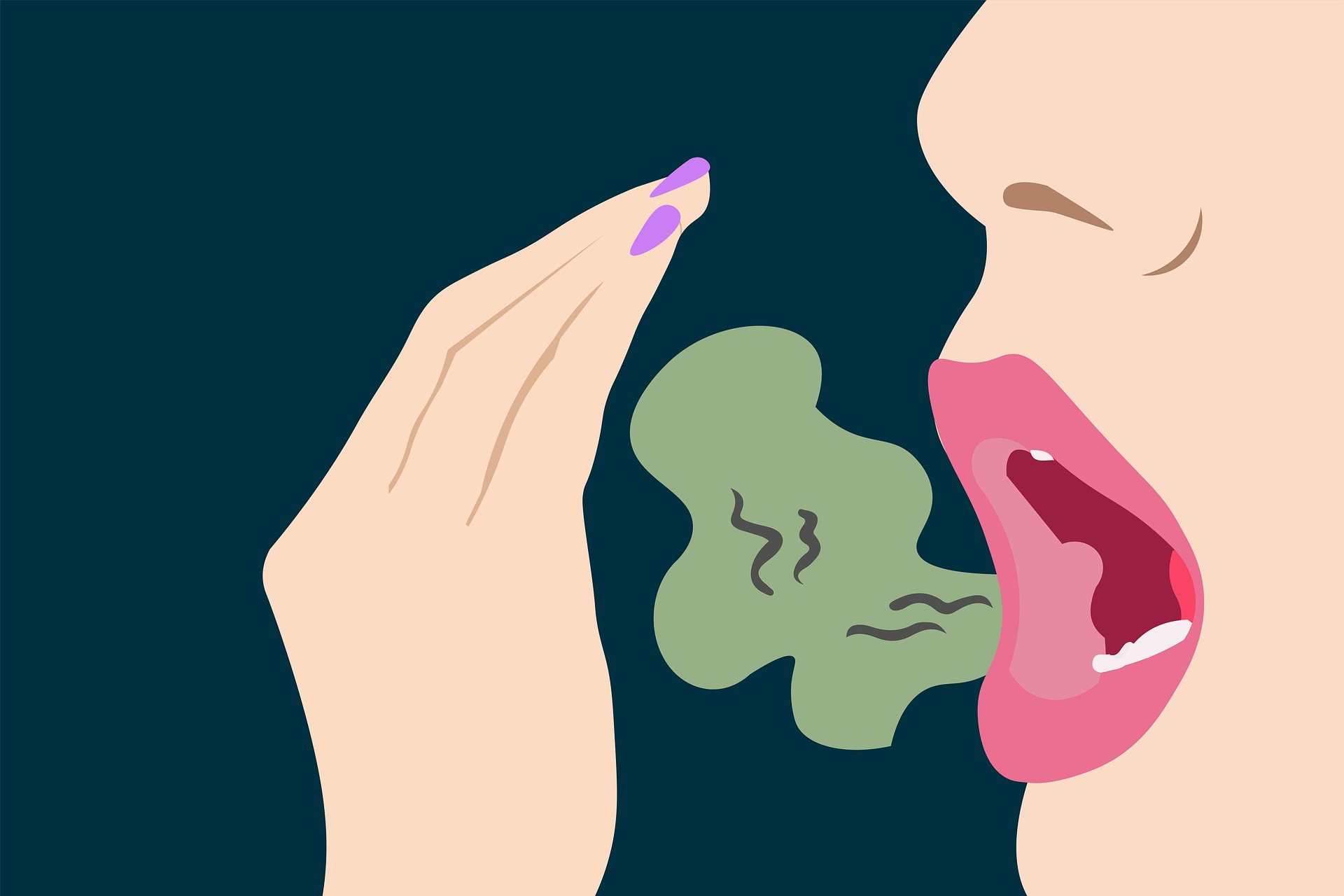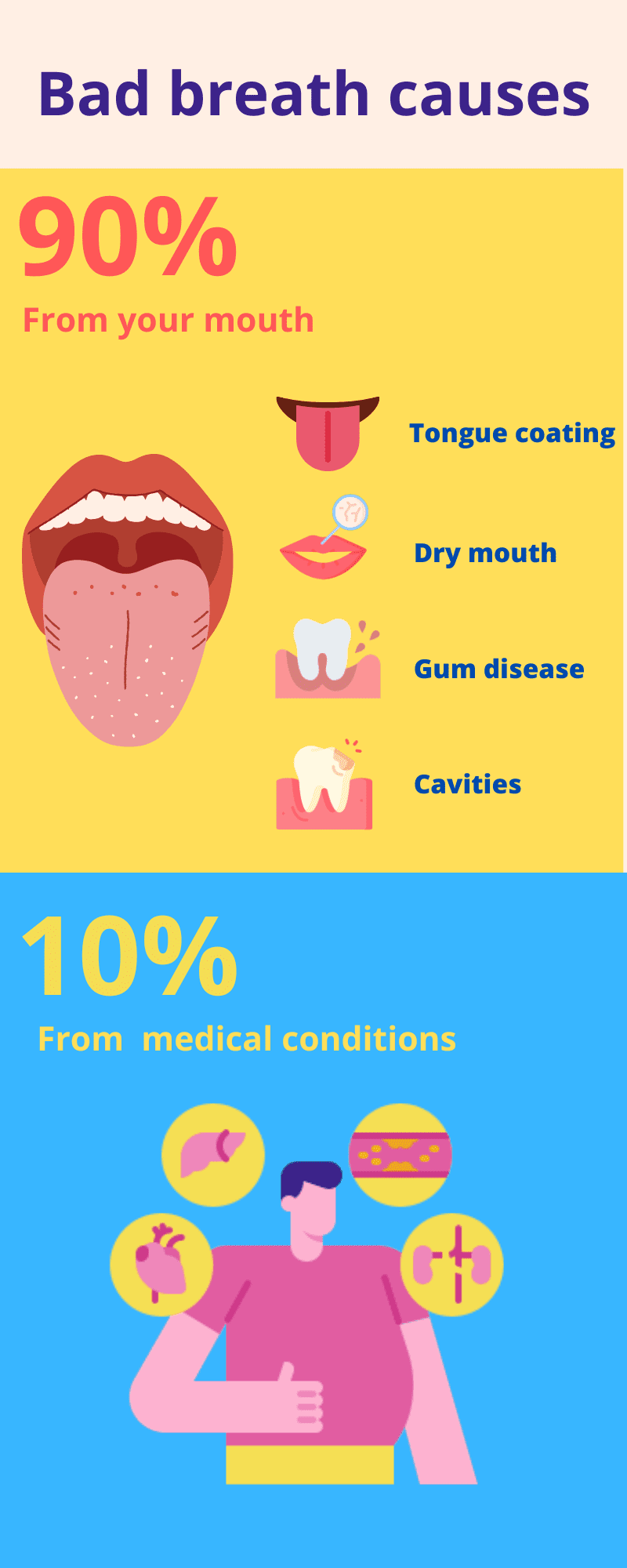Bad breath: Discover the cause to get rid of it for good
 Occasional bad breath is nothing to worry about. Most of us have experienced it at some point. However, chronic, persistent, and long-lasting bad breath is a real cause for concern. It can affect your professional and social life and be a source of anxiety.
Occasional bad breath is nothing to worry about. Most of us have experienced it at some point. However, chronic, persistent, and long-lasting bad breath is a real cause for concern. It can affect your professional and social life and be a source of anxiety.
Understanding and identifying the cause is the first step in dealing with it. Although oral conditions are the most common factors, other habits and underlying general diseases can also be involved.
In this article, you will learn about the different forms of bad breath, how it occurs, the possible causes, and treatment options to get rid of it for good.
Understanding halitosis or the bad breath issue:
 Bad breath is not a disease or condition in itself. It is a symptom of an underlying problem.
Bad breath is not a disease or condition in itself. It is a symptom of an underlying problem.
Most forms of bad breath come from the mouth. Some oral bacteria break down proteins from food particles, residues, and saliva to produce malodorous substances called volatile sulfur compounds (VSCs).
Under healthy conditions, these bacteria live in harmony in our mouths without causing any harm. However, certain factors can cause them to multiply and overproduce VSCs.
Aside from the mouth, bad breath can originate from various sources. These include:
- Foods and drinks: Consuming foods like garlic, onions, and drinks such as alcohol can cause bad breath after digestion. This unpleasant odor can linger for hours—garlic, in particular, is well-known for causing bad breath that lasts up to 72 hours!
- Fasting or low-carb diets: These can contribute to bad breath by increasing the breakdown of fats and proteins in the body. Additionally, reduced saliva flow during fasting can help bacteria grow, leading to VSCs overproduction.
- Medical conditions: Certain health conditions can cause bad breath as well. Examples include diabetes, kidney, and liver disease, and gastrointestinal issues that result in acid reflux.
- Medications: Some medications can release substances that produce foul smells and reduce saliva production. Antidepressants, antipsychotics, diuretics, and blood pressure medications are among the culprits.
- Pseudohalitosis or halitophobia: This less common form of bad breath is characterized by perceiving a foul smell in the mouth, even when the breath is normal. It is a result of extreme anxiety and excessive concern about dental health and hygiene products.
Fact:
The nature and type of bad breath can be an indicator of the underlying condition:
- Fruity or Sweet Odor: Uncontrolled diabetes.
- Ammonia-like Odor: Kidney problems.
- Fishy Odor: Trimethylaminuria (fish odor syndrome).
- Sour or Acidic Odor: Acid reflux or GERD.
- Rotten Egg Smell: Poor oral hygiene or bacterial breakdown of proteins.
- Fecal Odor: Gastrointestinal issues, such as obstruction, constipation, or infection.
- Putrid or Foul Odor: Respiratory infections or lung conditions like bronchitis or lung abscess.
The common causes of bad breath
90% of bad breath comes from the mouth. Most of the bacteria involved are anaerobic, which means they need an oxygen-free environment to grow and release their foul-smelling compounds (VSCs).The ideal spots for these bacteria inside the mouth are narrow, deep crevices—such as along the gum line and between the tiny projections (papillae) on the tongue.
The most common factors that increase bad breath include:
- Tongue coating: This is a thick, soft film filled with bacteria, dead cells, and debris that builds up on the tongue. It is the main source of VSCs in the mouth, accounting for 60-70% of the total.
- Gum diseases: This is an inflammatory condition that affects the gums and surrounding tooth tissues, including the bone. In advanced stages, it can cause the space between the teeth and gums to widen, resulting in periodontal pockets.
These pockets are the perfect environment for anaerobic bacteria to grow and release toxins. Therefore, the more periodontal pockets you have, the more CSVs you have in your mouth. - Cavities: Tooth decay or cavities are infectious diseases caused by bacteria. Bacteria convert the sugars in the food we eat into acid and gradually eat away at the tooth's enamel and dentin. They leave behind dead tissue and attract plaque and food particles, causing bad breath.
- Dry mouth: This happens due to a lack of saliva in the mouth. Saliva acts as the mouth’s natural cleanser and lubricant. When saliva production decreases, food particles and bacterial plaque build up more easily. A dry mouth can also increase your risk of other oral problems, including tooth decay and gum disease.
- Build up of food between teeth: When teeth are crowded or do not fit together properly, they can trap food and plaque.
- Old and worn dentures: Ill-fitting dentures can cause bacteria to overgrow and cause bad odor. They can also damage the surrounding tissue and cause a yeast infection known as oral thrush.
- Smoking: Tobacco and its by-products can leave chemical compounds in your mouth that can cause bad breath.
How to treat and prevent bad breath?
Bad breath is not a disease itself but a sign of an underlying problem. To truly fix it once and for all, you need to identify the real cause behind it.Treatment usually involves two parts:
- Temporarily masking bad breath with oral hygiene products.
- A long-term solution by addressing the underlying factors.
1. Temporary masking bad breath:
These products are not designed to treat bad breath permanently but can provide temporary, refreshing relief.
When should you use them? Anytime you need a quick fix—like before a meeting or any social interaction.
1. Chewing gums:
Sugar-free chewing gum works by stimulating saliva flow. Just be sure to choose one that is sugar-free and contains xylitol, because sugary gums can actually promote harmful bacteria and make the problem worse.One study showed that chewing xylitol gum can significantly reduce bad breath, lowering it from 71% to 52% within minutes.
2. Mouthwash:
Some mouthwashes contain active ingredients that neutralize foul-smelling compounds. They are also formulated with freshening agents like menthol and eucalyptol.Look for options that include chlorine dioxide and zinc salts—these are known to be the most effective against bad breath.
Some good alcohol-free mouthwashes to consider are SmartMouth, TheraBreath, and Oxyfresh.
3. Natural approaches:
Many natural remedies have been proven to temporarily relieve bad breath. The best known are green tea and essential oils.Green tea has antimicrobial and odor-neutralizing properties that can quickly reduce volatile sulfur compounds (VSCs) in your mouth.
Peppermint essential oils are also effective, thanks to their menthol content, which provides a strong, refreshing scent. That’s why most toothpaste and mouthwashes are mint-flavored.
Most importantly, drink plenty of water throughout the day. Keeping your mouth moist helps prevent the overgrowth of odor-causing bacteria.
2. Permanent treatment:
Permanent treatment focuses on addressing the root cause of halitosis.
This may include:
- Removing the white tongue coating: This is a primary cause of bad breath since most odor-producing bacteria live on the tongue.
- Improving your oral hygiene routine: Proper brushing, flossing, and regular tongue cleaning can make a significant difference.
- Treating underlying oral conditions: It’s important to address any dental issues such as infections, cavities, or gum disease, as these can contribute to bad breath.
The goal of these approaches is to reduce the bacterial load in your mouth and restore a healthy balance to your oral microbiome for long-term success.
Takeaway
Occasional bad breath is normal. However, when it becomes chronic, long-lasting, or persists even after thorough brushing and flossing, it may be a sign that something is wrong.The first priority should be finding the cause, because bad breath is a symptom, not a disease itself.
Sometimes, all you need is to improve your oral hygiene routine by using the right brushing and flossing techniques. Most importantly, clean your tongue daily—preferably with a tongue scraper, which can reduce volatile sulfur compounds by 42%, compared to only 33% when using a toothbrush.
If the problem persists, don’t wait to see your dentist, as it could be a dental issue that requires attention.
- Volatile Sulfur Compounds as The Cause of Bad Breath: A Review https://www.tandfonline.com/doi/abs/10.1080/10426507.2012.736894?journalCode=gpss20
- Dorsal Lingual Surface and Halitosis: a Morphological Point of View https://www.ncbi.nlm.nih.gov/pmc/articles/PMC5080560/
- Effect of chewing gums on the production of volatile sulfur compounds (VSC) in vivo https://pubmed.ncbi.nlm.nih.gov/19601490/
- Effect of green tea on volatile sulfur compounds in mouth air https://pubmed.ncbi.nlm.nih.gov/18388413/
- Effect of essential oils on oral halitosis treatment: a review https://onlinelibrary.wiley.com/doi/full/10.1111/eos.12745
- Halitosis: From diagnosis to management https://www.ncbi.nlm.nih.gov/pmc/articles/PMC3633265/